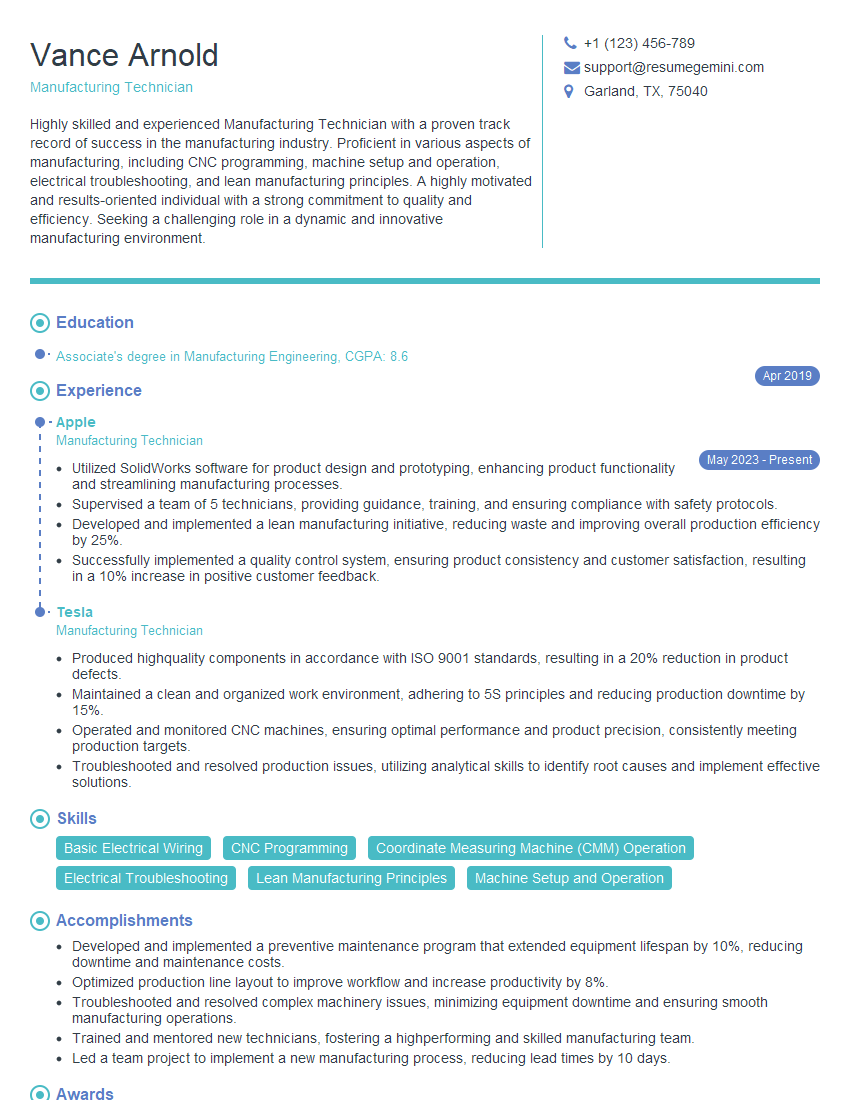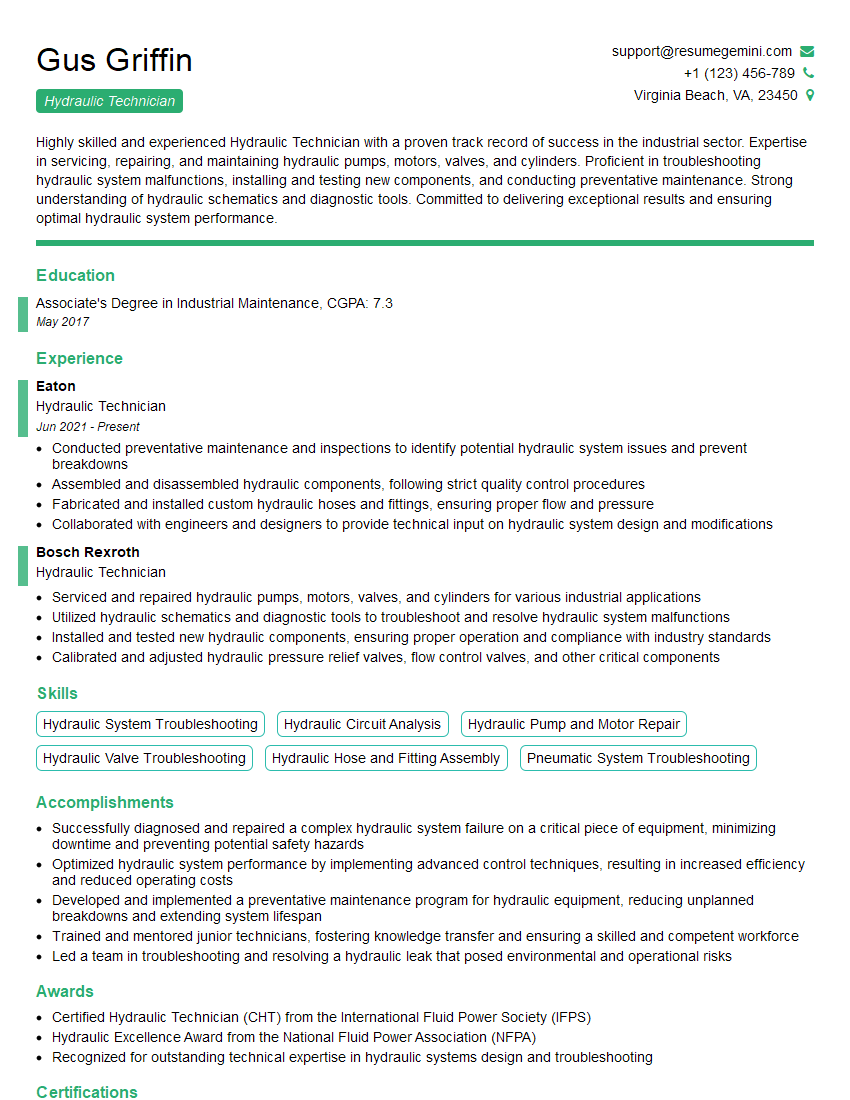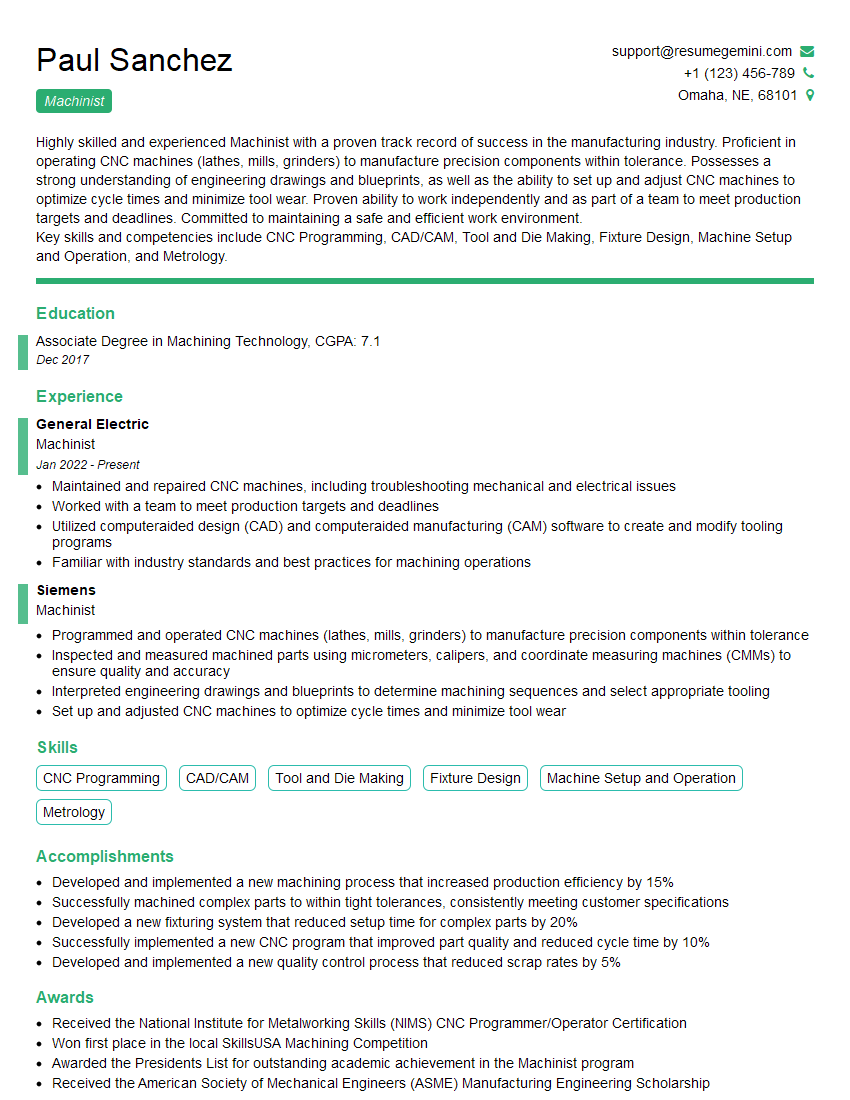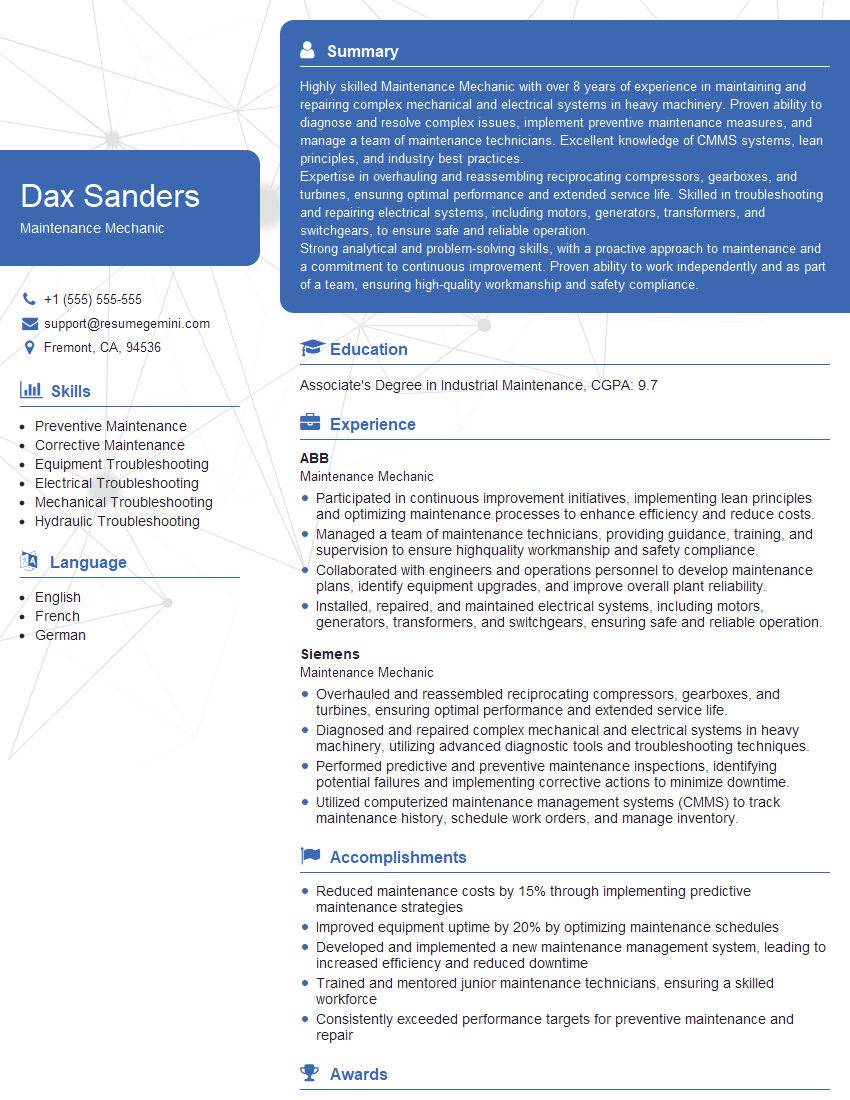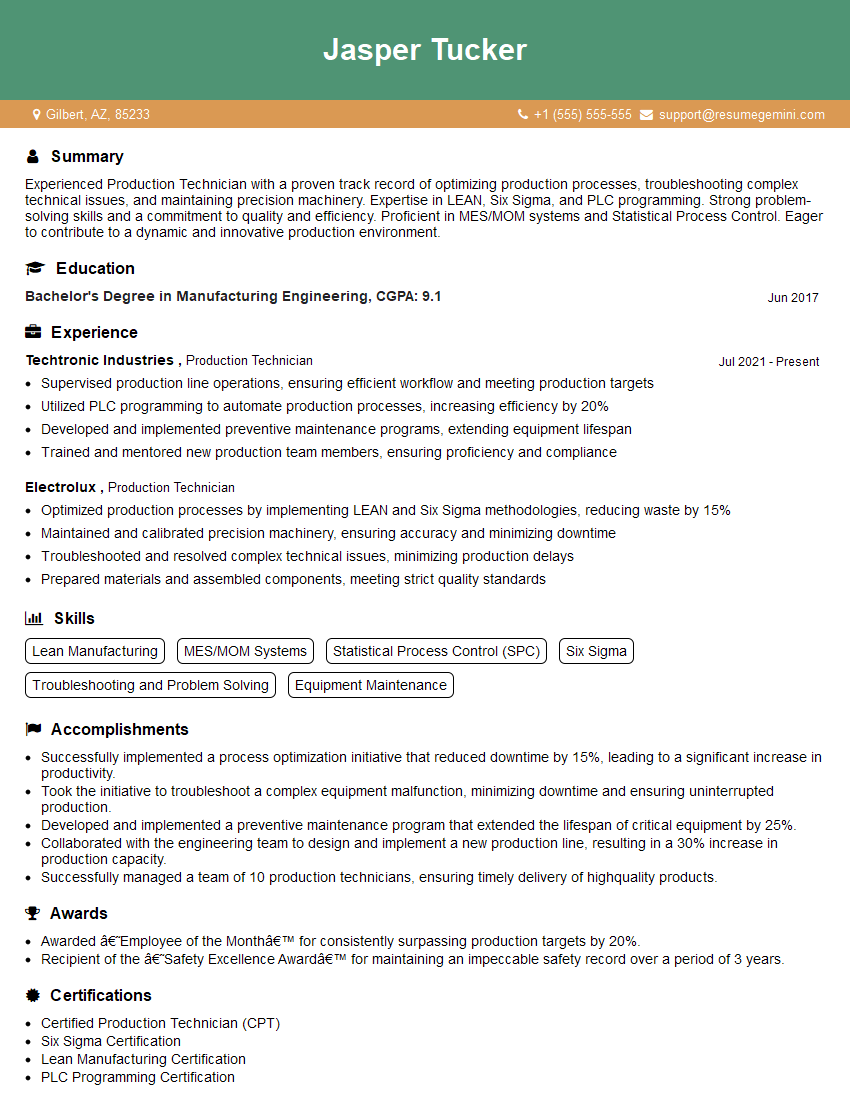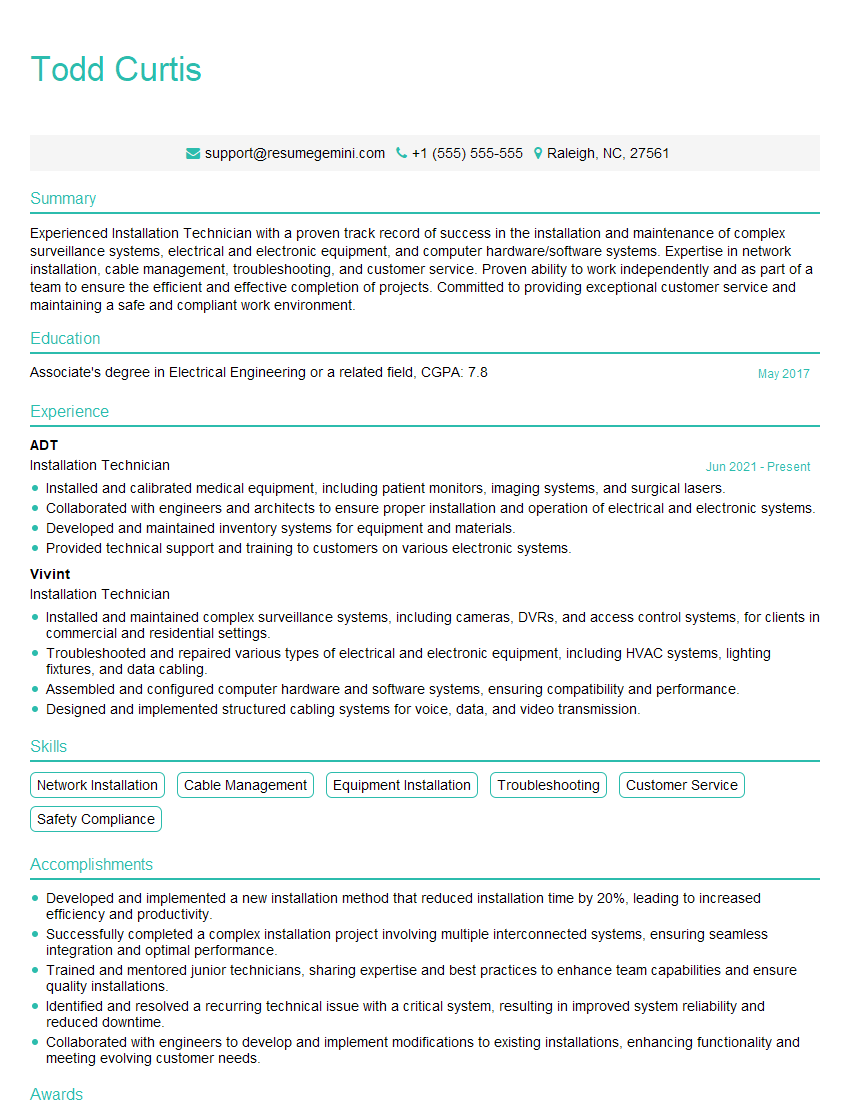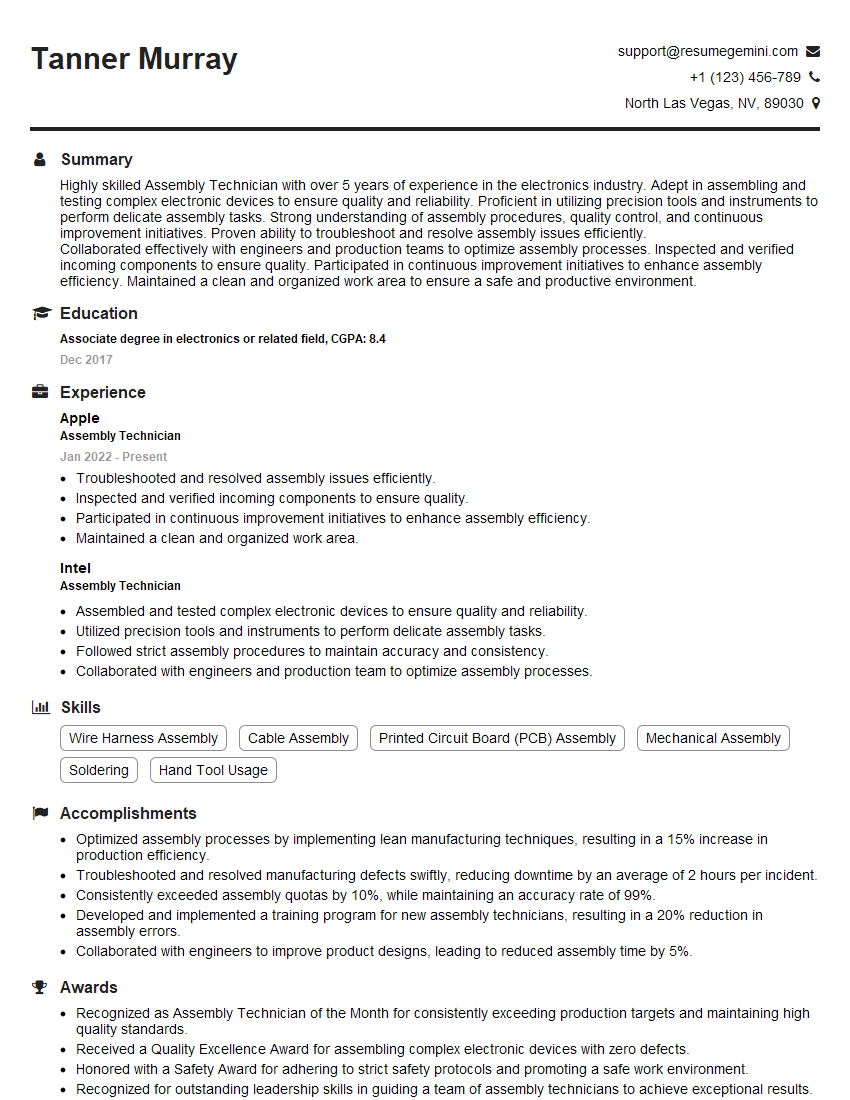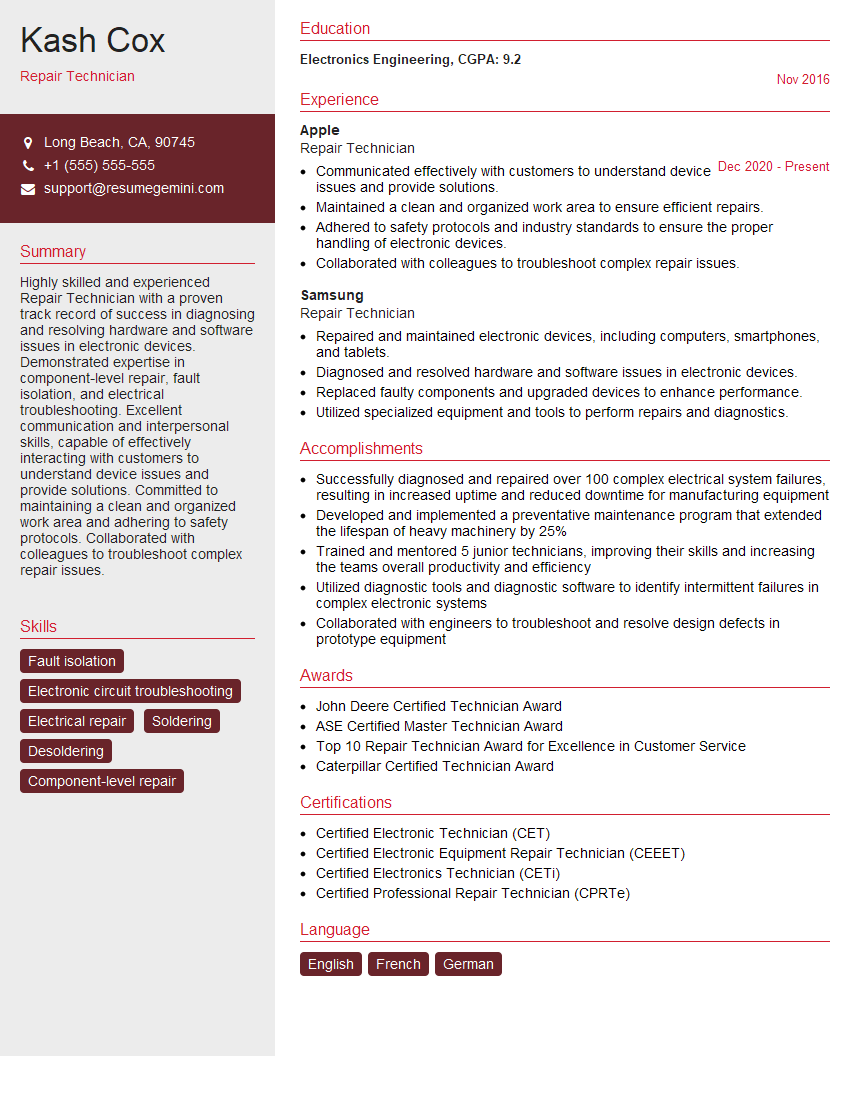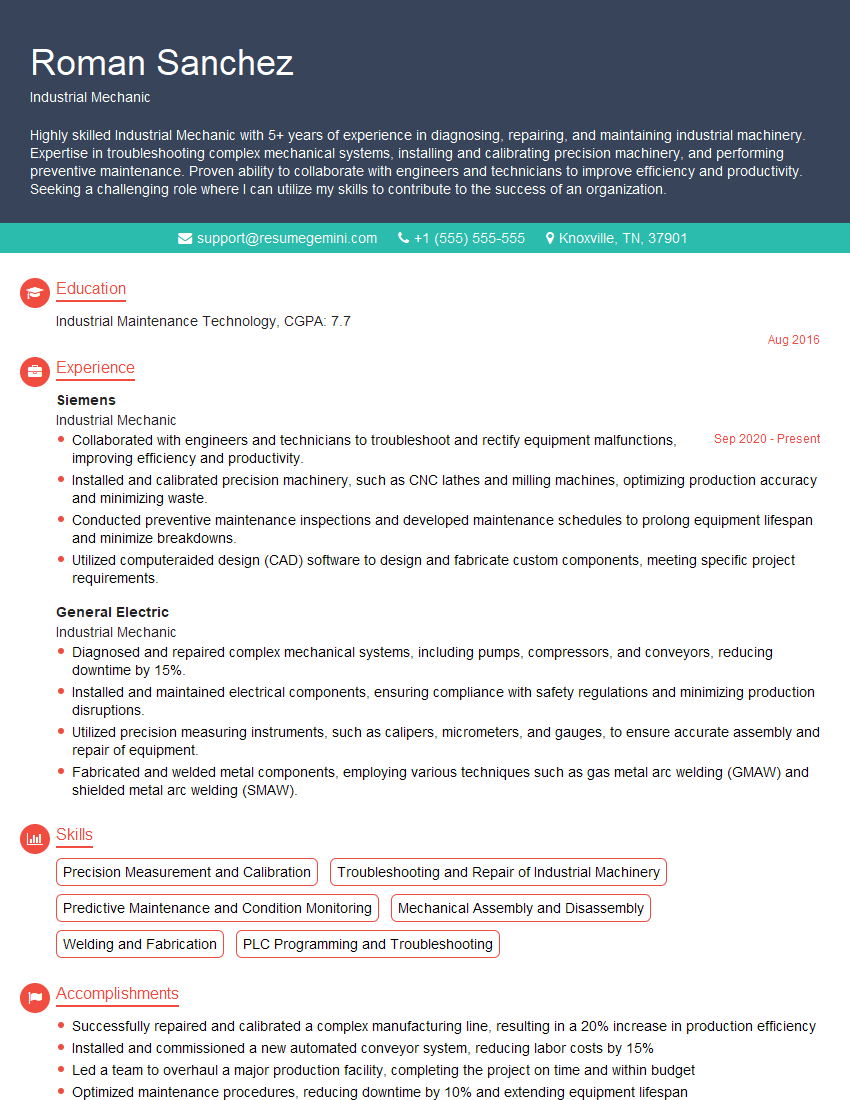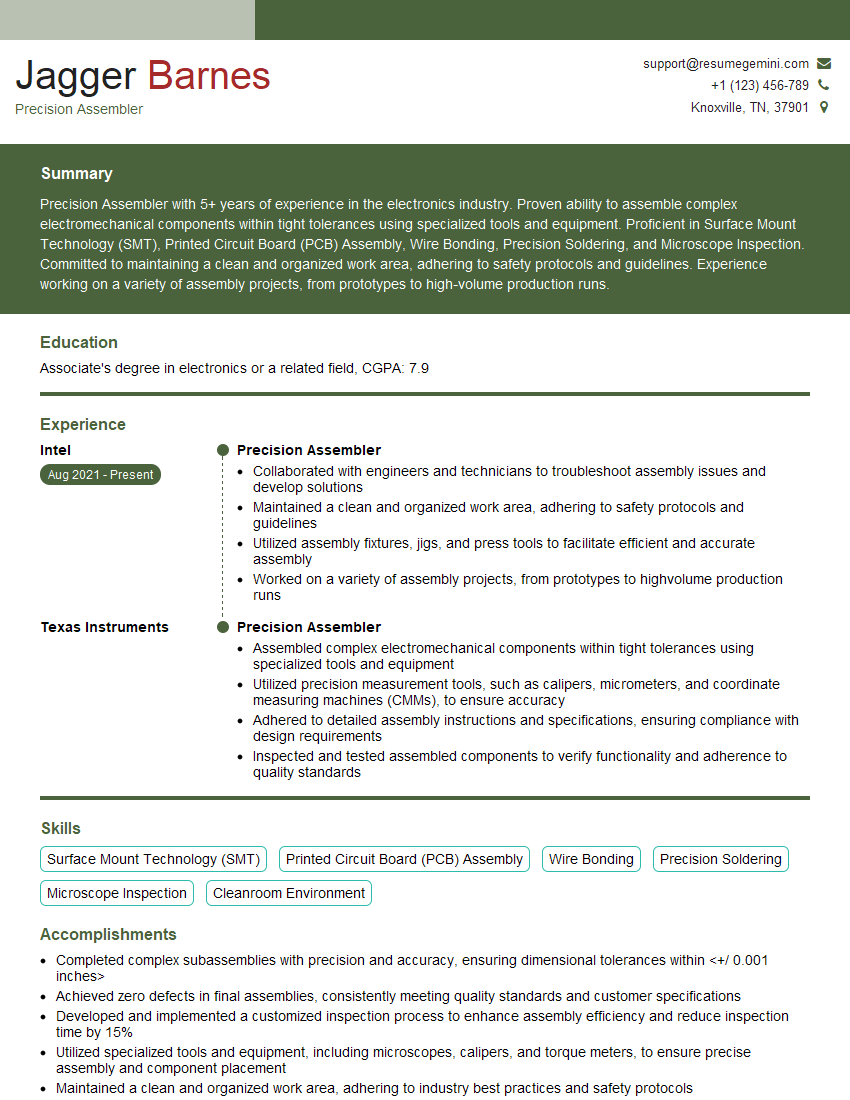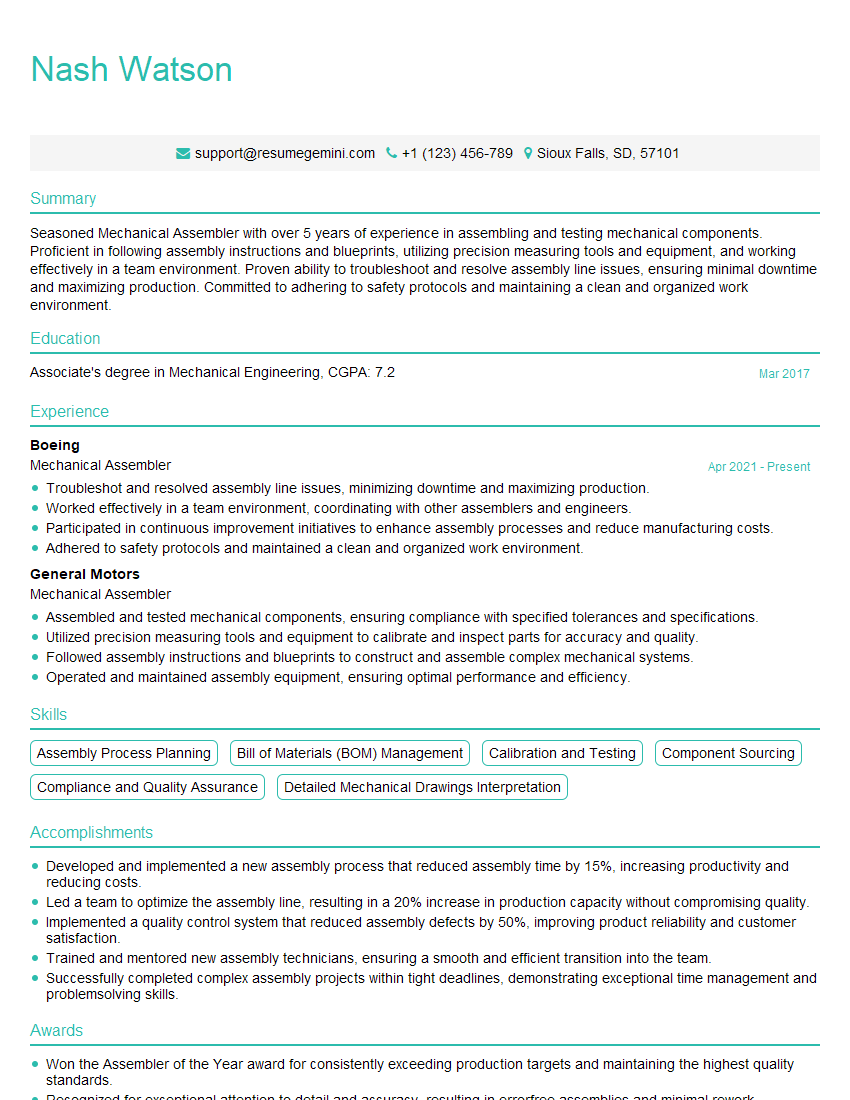The thought of an interview can be nerve-wracking, but the right preparation can make all the difference. Explore this comprehensive guide to Coupling assembly and disassembly interview questions and gain the confidence you need to showcase your abilities and secure the role.
Questions Asked in Coupling assembly and disassembly Interview
Q 1. Explain the different types of couplings.
Couplings are mechanical devices used to connect two shafts, transmitting torque and rotational motion between them. They come in various types, each designed for specific applications and operational requirements. The selection depends on factors like the amount of torque to be transmitted, the desired misalignment compensation, and the operating environment.
- Rigid Couplings: These couplings transmit torque without allowing any misalignment. Examples include flange couplings, sleeve couplings, and clamp couplings. They are simple, inexpensive, and efficient for applications with perfectly aligned shafts.
- Flexible Couplings: These accommodate some degree of misalignment (angular, parallel, or axial). Common types include gear couplings, elastomeric couplings (like polyurethane or rubber couplings), jaw couplings, and universal joints. They are crucial where perfect shaft alignment is difficult to achieve or maintain.
- Fluid Couplings: These transmit torque through a fluid medium, providing a smooth start-up and overload protection. They often incorporate a hydraulic system and are used in high-torque applications.
- Magnetic Couplings: These use magnetic fields to transmit torque across an air gap, making them suitable for applications requiring isolation or sealing, such as in hazardous environments.
Choosing the right coupling is critical for reliable operation. A poorly selected coupling can lead to premature wear, vibration, and catastrophic failure.
Q 2. Describe the process of assembling a rigid flange coupling.
Assembling a rigid flange coupling is a relatively straightforward process, but precision is key to ensuring proper function and avoiding damage. Imagine it like connecting two pipes with a strong, secure clamp.
- Clean the mating surfaces: Thoroughly clean the flanges of both shafts to remove any dirt, grease, or debris. This ensures a proper seal and prevents corrosion.
- Align the shafts: Carefully align the shafts to ensure perfect concentricity. Misalignment, even slight, can induce significant stress and lead to failure.
- Bolt installation: Install the bolts evenly, tightening them in a star pattern (opposite bolts tightened alternately). This prevents warping of the flanges. Use a torque wrench to ensure the bolts are tightened to the manufacturer’s specified torque.
- Torque verification: After tightening, re-check the torque on all bolts to ensure consistent clamping force.
- Final inspection: Inspect the assembled coupling for any signs of damage or misalignment before operation.
Failure to follow these steps can result in a loose connection, vibrations, and ultimately coupling failure.
Q 3. What safety precautions are crucial during coupling disassembly?
Disassembling couplings can be dangerous if not handled properly. Think of it like disarming a bomb; caution is essential.
- Lockout/Tagout (LOTO): Always follow LOTO procedures before beginning disassembly. This ensures the equipment is completely de-energized and safe to work on. This is non-negotiable.
- Personal Protective Equipment (PPE): Wear appropriate PPE, including safety glasses, gloves, and possibly hearing protection depending on the application.
- Support the shafts: Ensure the shafts are adequately supported to prevent them from falling or shifting during disassembly.
- Controlled disassembly: Use appropriate tools to carefully remove bolts and other fasteners. Avoid using excessive force, which can damage components.
- Careful handling of components: Handle coupling components carefully to avoid damage. Many components are precisely manufactured and delicate.
Ignoring safety precautions can lead to serious injury or equipment damage.
Q 4. How do you identify a damaged coupling?
Identifying a damaged coupling requires careful visual inspection and sometimes further investigation.
- Visual inspection: Look for cracks, fractures, wear, corrosion, or deformation of the coupling components. Pay close attention to the areas experiencing the highest stress.
- Excessive vibration: Unusual vibration levels can indicate a problem with the coupling, including wear, misalignment, or imbalance.
- Leakage (for fluid couplings): Fluid leakage indicates a seal failure and requires immediate attention.
- Unusual noises: Grinding, rattling, or other unusual noises during operation could indicate damage within the coupling.
- Torque measurement: A significant reduction in transmitted torque compared to the expected value points to a problem.
When in doubt, it’s best to replace a suspect coupling to avoid potential failure.
Q 5. Explain the importance of proper torque specifications during assembly.
Proper torque specifications are crucial for ensuring the coupling functions correctly and safely. Think of it like tightening the bolts on a wheel – too loose and it’s dangerous, too tight and it can damage the components.
Applying the correct torque ensures:
- Secure connection: Prevents slippage and ensures proper torque transmission.
- Prevents damage: Avoids over-tightening which can strip threads, damage flanges, or induce excessive stress.
- Consistent performance: Ensures the coupling operates reliably within its design parameters.
Torque values are usually provided by the coupling manufacturer. A torque wrench is essential for accurate application of torque during assembly.
Q 6. What are the common causes of coupling failure?
Coupling failures can have various causes, often stemming from a combination of factors.
- Misalignment: Angular, parallel, or axial misalignment puts excessive stress on the coupling components, leading to premature wear and failure.
- Overload: Exceeding the rated torque capacity of the coupling can result in damage or failure.
- Corrosion: Environmental factors can lead to corrosion of the coupling components, weakening their structural integrity.
- Improper installation: Incorrect installation, such as improper tightening of bolts or misalignment, can cause premature failure.
- Wear and tear: Normal wear and tear can eventually lead to coupling failure, especially in high-cycle applications.
- Material fatigue: Repeated cyclical loading can lead to fatigue failure of the coupling components.
Regular inspection and maintenance are crucial for identifying potential issues before they lead to failure.
Q 7. How do you troubleshoot a misaligned coupling?
Troubleshooting a misaligned coupling involves a systematic approach to identify and correct the misalignment.
- Visual inspection: Carefully inspect the coupling for signs of misalignment, such as uneven gaps or uneven wear.
- Alignment tools: Use dial indicators or laser alignment tools to precisely measure the degree and type of misalignment (angular, parallel, or axial).
- Identify the source: Determine the source of misalignment. This may involve checking the shaft bearings, motor mounts, or other supporting structures.
- Correct the misalignment: Adjust the position of the shafts or equipment to correct the misalignment. This may involve shimming, adjusting motor mounts, or realigning bearings.
- Re-check alignment: After adjustments, re-check the alignment using alignment tools to ensure the problem is resolved.
- Monitor performance: Monitor the coupling’s performance after repair to ensure that the misalignment is completely corrected and that the coupling is operating smoothly.
Ignoring misalignment can lead to premature wear, vibration, and ultimately coupling failure. Accurate alignment is key to a long and efficient lifespan.
Q 8. Describe the procedure for disassembling a flexible coupling.
Disassembling a flexible coupling depends heavily on its type. However, the general procedure involves careful, step-by-step removal of components, prioritizing safety. Let’s take a common example – a flexible jaw coupling. First, ensure the machinery is completely powered down and locked out/tagged out to prevent accidental activation. Then:
- Remove the coupling guards or protective casing, if present. This allows for clear access to the coupling components.
- Remove any retaining bolts or fasteners securing the coupling halves to the shafts. Take note of the bolt sequence and torque specifications for reassembly.
- Carefully separate the coupling halves. Some couplings may require slight tapping with a soft mallet to break the connection. Avoid using excessive force, which could damage the coupling elements.
- Inspect the components for wear, tear, or damage. Note any irregularities for further analysis.
- Clean the coupling components thoroughly. Remove any debris or old lubricant before storing or reassembling.
Remember, always consult the manufacturer’s instructions for specific disassembly procedures for the exact coupling type. Each coupling is unique, and the steps may vary slightly.
Q 9. What tools and equipment are necessary for coupling assembly and disassembly?
The tools and equipment required for coupling assembly and disassembly vary depending on the coupling type and size. However, a basic toolkit should include:
- Sockets and wrenches (various sizes) to remove and tighten fasteners.
- Torque wrench to ensure proper bolt tightening, preventing damage.
- Alignment tools (e.g., dial indicators, laser alignment systems) for accurate shaft alignment.
- Soft mallet for gently separating coupling halves.
- Cleaning supplies (e.g., brushes, solvents) to remove dirt and old grease.
- Lubrication equipment (e.g., grease gun, oil can) for applying new lubricant.
- Safety equipment (e.g., safety glasses, gloves) to protect against injuries.
For larger or more complex couplings, specialized tools and equipment such as hydraulic presses or lifting gear might be necessary. Always prioritize safety and use the appropriate personal protective equipment (PPE).
Q 10. How do you ensure the proper lubrication of a coupling?
Proper lubrication is crucial for extending the lifespan and efficient operation of a coupling. The specific lubrication method depends on the coupling type (e.g., grease, oil). Always follow the manufacturer’s recommendations. Here’s a general approach:
- Clean the coupling components thoroughly before applying new lubricant. Remove old grease or oil and any contaminants.
- Apply the correct type and amount of lubricant. Over-lubrication can lead to leakage and contamination, while under-lubrication causes premature wear.
- Use a grease gun or oil can for efficient application. Ensure the lubricant reaches all critical points within the coupling.
- Regularly inspect the lubrication. Check for leaks, signs of degradation, or contamination. Replenish lubricant as needed.
Imagine a bicycle chain – regular lubrication keeps it smooth and prevents rust and wear. Similarly, proper coupling lubrication ensures smooth torque transmission and prevents premature failure.
Q 11. Explain the difference between a jaw coupling and a gear coupling.
Jaw couplings and gear couplings are both types of flexible couplings, but they differ in their design and operation:
- Jaw Couplings: These consist of two hubs with flexible jaws that intermesh. They accommodate moderate misalignment and are relatively simple to install and maintain. Think of it like interlocking fingers – they allow for some give.
- Gear Couplings: These utilize internal and external gear teeth that mesh together. They offer higher torque capacity and can accommodate more significant misalignment than jaw couplings. They function like finely-tuned gears working in unison.
The choice between a jaw coupling and a gear coupling depends on the specific application requirements, considering factors such as torque capacity, misalignment tolerance, and cost.
Q 12. How do you inspect a coupling for wear and tear?
Inspecting a coupling for wear and tear is essential for preventative maintenance. This typically involves:
- Visual inspection: Check for cracks, deformations, or significant wear on the coupling components. Look for signs of excessive corrosion or damage.
- Measurement of clearances: For couplings with moving parts, check for excessive play or looseness. This indicates wear and potential failure.
- Examination of lubrication: Inspect the lubricant for degradation, contamination, or insufficient quantity.
- Check for vibrations: Excessive vibrations can be an indicator of coupling problems such as imbalance or misalignment.
A thorough inspection can help identify potential issues before they lead to catastrophic failures, avoiding costly downtime and repairs. Think of it like a doctor’s check-up – regular inspections keep things running smoothly.
Q 13. What are the consequences of improper coupling assembly?
Improper coupling assembly can lead to several serious consequences:
- Misalignment: This can cause increased vibration, noise, and premature wear on the coupling and connected machinery.
- Reduced torque transmission: Improper assembly can reduce the coupling’s ability to efficiently transfer torque, leading to performance issues.
- Premature failure: Improperly assembled couplings are prone to early failure, potentially resulting in costly downtime and repairs.
- Safety hazards: A failed coupling can cause unexpected machinery stops or component failure, potentially leading to injuries or damage.
Imagine building a tower of blocks – if the base isn’t secure, the whole structure is at risk. Proper assembly is crucial for the reliable performance and safety of the entire system.
Q 14. Describe the process of aligning shafts before coupling installation.
Accurate shaft alignment is critical before coupling installation to prevent premature wear and ensure efficient operation. The alignment procedure typically involves these steps:
- Preparation: Ensure the shafts are clean and free of obstructions. Use appropriate lifting and support equipment for safety.
- Measurement: Employ alignment tools such as dial indicators or laser alignment systems to measure the parallelism and concentricity of the shafts. Follow manufacturer guidelines for measurement tolerances.
- Adjustment: If misalignment is detected, adjust the shaft positions using shims, adjustable baseplates, or other alignment mechanisms. Iterative measurements and adjustments are needed to achieve the desired accuracy.
- Verification: After adjustments, verify alignment using the same measurement methods. Repeat adjustments as needed to meet the specified tolerances.
Accurate shaft alignment is like preparing a perfect foundation for a house. Without a solid base, the house will be unstable. Similarly, proper shaft alignment is crucial for the reliable operation and longevity of the coupled machinery.
Q 15. How do you handle different coupling materials (e.g., metal, plastic)?
Handling different coupling materials requires understanding their unique properties and adapting assembly/disassembly techniques accordingly. Metal couplings, often steel or aluminum, are typically robust and require specialized tools for disassembly, potentially involving impact wrenches or hydraulic presses for stubborn connections. Plastic couplings, on the other hand, are generally more forgiving and may be disassembled using simpler tools like screwdrivers or hand wrenches, but care must be taken to avoid damage from excessive force. The key is to always consult the manufacturer’s specifications for torque values and recommended tools. For example, a mismatched tool on a plastic coupling could easily strip the threads or crack the material.
Consider the environmental conditions. If the coupling is exposed to extreme temperatures or chemicals, material selection becomes even more critical. For example, a high-temperature application might call for a specialized metal alloy coupling with higher heat resistance, while a chemical processing plant might require couplings made of a chemically resistant polymer.
Career Expert Tips:
- Ace those interviews! Prepare effectively by reviewing the Top 50 Most Common Interview Questions on ResumeGemini.
- Navigate your job search with confidence! Explore a wide range of Career Tips on ResumeGemini. Learn about common challenges and recommendations to overcome them.
- Craft the perfect resume! Master the Art of Resume Writing with ResumeGemini’s guide. Showcase your unique qualifications and achievements effectively.
- Don’t miss out on holiday savings! Build your dream resume with ResumeGemini’s ATS optimized templates.
Q 16. What are the key considerations for selecting a suitable coupling?
Selecting a suitable coupling involves considering several key factors. Firstly, power transmission requirements: the torque and speed capacity of the coupling must exceed the operating conditions to ensure reliable performance. Secondly, misalignment capabilities: different couplings handle various misalignment types (angular, parallel, axial) differently. The level of misalignment expected should guide the selection. For instance, a flexible coupling is essential in applications with significant misalignment possibilities, whereas a rigid coupling is suitable only where precise alignment is ensured. Thirdly, operating environment: factors like temperature, humidity, and exposure to chemicals influence material selection and coupling durability. Fourthly, maintenance requirements: some couplings are easier to maintain and replace than others. Finally, cost: while crucial, it shouldn’t compromise other critical factors like performance and safety.
For instance, in a high-speed, high-torque industrial pump application, a robust metal gear coupling may be preferable for its strength and durability. However, a less demanding application, like a small conveyor belt system, might only need a simple elastomeric coupling for its flexibility and ease of use.
Q 17. Explain the role of shims in coupling alignment.
Shims are thin, precisely manufactured pieces of material, typically metal, used in coupling alignment to compensate for minor misalignments between shafts. They are placed between the coupling halves and the shafts to adjust the relative positions. This is particularly crucial for rigid couplings, which cannot accommodate any significant misalignment. By carefully adding or removing shims, the technician ensures accurate shaft alignment before tightening the coupling, minimizing vibration and stress on the connected machinery.
Think of shims as tiny, adjustable spacers. Just like you might use spacers to level a piece of furniture, shims allow for fine-tuning of alignment in mechanical systems. Improper shim usage can lead to excessive wear on the coupling and connected equipment and even catastrophic failure.
Q 18. How do you address vibration issues related to couplings?
Vibration issues in couplings are often caused by misalignment, imbalance, or coupling wear. Addressing these requires a systematic approach. Firstly, check for misalignment: use alignment tools like dial indicators to ensure proper shaft alignment. If misalignment is present, correct it using shims or other alignment techniques. Secondly, inspect the coupling for wear and damage: replace any worn or damaged components. Thirdly, ensure proper lubrication: lubricating couplings that require it reduces friction and vibration. Fourthly, consider vibration dampening techniques: this may involve using specialized couplings with vibration-dampening elements or adding additional dampening devices to the system. In some cases, resonance frequencies need investigation and potentially changes to the system’s operating parameters.
For example, if a coupling exhibits excessive vibration after initial installation, the first step would be a thorough alignment check. If alignment is the culprit, shim adjustments will likely remedy the issue. Otherwise, further investigation into possible wear, lubrication issues, or resonance issues is warranted.
Q 19. What are the different types of flexible couplings?
Flexible couplings allow for some degree of misalignment between shafts, preventing damage to the connected equipment. Several types exist:
- Elastomeric couplings: These use rubber or other elastomeric materials to absorb misalignment and vibration. They are commonly used in low-torque applications.
- Jaw couplings: These consist of two hubs with interlocking jaws that transmit torque. They are suitable for moderate misalignment and torque levels.
- Gear couplings: These use internal gears to transmit torque. They are strong and can handle higher torque and misalignment.
- Beam couplings: They employ flexible beams to allow for misalignment, offering high torsional stiffness and capacity.
- Fluid couplings: These use a fluid medium to transmit torque, providing smooth starting and overload protection.
The choice depends on the specific application requirements. A low-torque application might only need an elastomeric coupling, while a high-torque, high-speed application might require a gear coupling or a more robust solution like a beam coupling.
Q 20. Describe the process of replacing a damaged coupling.
Replacing a damaged coupling requires a systematic approach. Firstly, safely disconnect the equipment: isolate the power source, remove guarding, and follow all lockout/tagout procedures. Secondly, remove the old coupling: this often involves removing fasteners and potentially using specialized tools depending on the coupling type and the degree of damage. Thirdly, inspect the shafts: ensure the shafts are not damaged, and clean them thoroughly. Fourthly, install the new coupling: carefully align the shafts, following the manufacturer’s instructions. For rigid couplings, precise alignment using shims is critical. Finally, re-engage the equipment, and perform a functional test, gradually bringing the system to full speed while monitoring vibration levels. Documentation of the entire process is crucial.
Imagine replacing a worn-out coupling in a large industrial fan. The process would involve carefully following the manufacturer’s instructions for disassembly, noting any wear on the shafts, precisely aligning the new coupling, and gradually increasing the fan speed to ensure proper operation.
Q 21. How do you maintain accurate records of coupling maintenance?
Maintaining accurate coupling maintenance records is vital for ensuring equipment reliability and preventing unexpected failures. A computerized maintenance management system (CMMS) is highly recommended. This could be as simple as a spreadsheet detailing coupling type, installation date, maintenance history (including dates of lubrication, inspections, and replacements), and any notable issues. More sophisticated CMMS software provides features such as automated alerts for scheduled maintenance, real-time tracking of maintenance activities, and historical data analysis to help identify patterns and predict future failures.
For example, a properly maintained record will show the history of lubrication changes, inspections for wear, and any repairs or replacements, along with the dates and personnel involved. This information is crucial for optimizing maintenance schedules, reducing downtime, and improving overall equipment lifespan.
Q 22. What are the common problems encountered during coupling installation?
Common problems during coupling installation often stem from misalignment, improper torque application, and inadequate lubrication. Misalignment, whether angular, parallel, or axial, is a major culprit, leading to premature wear, vibration, and ultimately, coupling failure. Incorrect torque can damage the coupling components or cause insufficient clamping force, resulting in slippage. Finally, insufficient or improper lubrication increases friction, generating heat and accelerating wear.
For example, imagine installing a flexible coupling on a pump and motor. If the shafts aren’t perfectly aligned, the coupling will compensate for this misalignment, but it will experience uneven stress, leading to shorter lifespan and potential failure. Similarly, applying too little torque will result in the coupling slipping under load, while over-tightening can crack the coupling body.
- Misalignment: Angular, parallel, or axial misalignment.
- Improper Torque: Too tight or too loose.
- Inadequate Lubrication: Lack of lubrication or use of incorrect lubricant.
- Damaged Components: Pre-existing damage on shafts or coupling parts.
Q 23. How do you ensure the safety of personnel during coupling work?
Safety during coupling work is paramount. It involves a multi-pronged approach including proper lockout/tagout procedures, using appropriate personal protective equipment (PPE), and following a detailed work plan. Before commencing any work, always isolate the power source completely and lock it out to prevent accidental startup. PPE should include safety glasses, gloves, and potentially steel-toed boots, depending on the specific coupling and machinery involved. A detailed work plan should be developed and reviewed with the team, outlining each step, potential hazards, and mitigation strategies. Regular safety briefings and training are crucial in maintaining a safe working environment.
For instance, when working with larger couplings, a lifting device or crane might be required, necessitating additional safety measures like spotters and ensuring the load is properly secured to prevent accidents. Clear communication amongst team members is also vital to ensure everyone is aware of ongoing procedures and potential risks.
Q 24. Explain the importance of using the correct coupling for the application.
Selecting the correct coupling is critical for optimal performance and longevity of the connected machinery. The wrong coupling can lead to premature failure, excessive vibration, misalignment issues, and potential damage to the equipment. The choice depends on several factors, including the type of machinery, the amount of misalignment that needs to be accommodated, the speed of the shafts, the torque requirements, and the operating environment (temperature, humidity, etc.).
Using a rigid coupling where a flexible one is needed will lead to excessive stress on the shafts and bearings and is unsuitable if any misalignment exists. Conversely, using a flexible coupling where a rigid one is appropriate could lead to excessive wear of the coupling elements and significant energy loss. Consider a pump application – if the pump needs to accommodate for some axial movement from thermal expansion, choosing a flexible coupling like a diaphragm coupling is vital.
Q 25. What are the limitations of different coupling types?
Different coupling types have distinct limitations. For example, rigid couplings offer high torsional stiffness but cannot accommodate any misalignment. Flexible couplings can handle some misalignment but have a lower torsional stiffness, leading to potential energy losses at higher speeds. Jaw couplings can tolerate significant misalignment but are limited in their speed capabilities. Fluid couplings offer smooth starts and shock absorption but suffer from slip and reduced efficiency.
- Rigid Couplings: No misalignment tolerance.
- Flexible Couplings (e.g., Elastomeric): Limited misalignment tolerance, potential for torsional vibration.
- Jaw Couplings: High misalignment tolerance, limited speed capabilities.
- Fluid Couplings: Smooth operation, but energy loss due to slip.
Q 26. How do you diagnose and rectify coupling misalignment issues?
Diagnosing coupling misalignment involves a systematic approach. Visual inspection can often reveal gross misalignment, but precise measurements are necessary for accurate assessment. Tools like dial indicators and laser alignment systems are used to measure the angular, parallel, and axial misalignment between shafts. Once the type and magnitude of misalignment are determined, corrective actions are taken. This might involve shimming the motor or driven machine base, adjusting the feet or mounting plates, or correcting shaft straightness.
For example, using a dial indicator, you might measure the runout of each shaft. If there’s a significant difference, you’ve identified misalignment. Then, by carefully adjusting the mounting, you can bring the shafts into alignment. Laser alignment systems provide a more accurate and efficient method for this process, especially on larger machines.
Q 27. Describe your experience with different coupling manufacturers and their products.
Throughout my career, I’ve worked extensively with various coupling manufacturers, including [Mention specific manufacturers, e.g., Reliance Electric, Lovejoy, etc. Avoid real company names for anonymity if needed] and their product lines. I’ve gained hands-on experience with diverse coupling types such as jaw couplings, flexible couplings, and rigid couplings from these manufacturers. This experience includes specifying, installing, troubleshooting, and maintaining their products in various industrial applications. I’ve found each manufacturer offers unique design features and quality standards. For example, [Mention a specific feature or design detail of a coupling] from one manufacturer consistently demonstrated superior performance in high-vibration environments.
Q 28. Explain your understanding of coupling tolerance and its importance.
Coupling tolerance refers to the allowable variations in dimensions and alignment between coupling components and shafts. Maintaining the correct tolerances is crucial for proper functionality and avoiding premature wear. Too much tolerance can lead to excessive play, vibration, and increased wear, while too little tolerance can hinder assembly, create stress concentrations, and lead to damage. These tolerances are specified by the coupling manufacturer and need to be carefully adhered to during installation and maintenance.
For example, a slight variation in shaft diameter outside the specified tolerance could prevent proper engagement of a coupling, requiring machining or replacement. Maintaining tight tolerance control ensures a snug fit, correct load transmission, and the prevention of vibrations which would cause premature failure.
Key Topics to Learn for Coupling Assembly and Disassembly Interview
- Types of Couplings: Understanding different coupling types (rigid, flexible, fluid, etc.) and their applications. This includes recognizing their strengths and weaknesses in various industrial settings.
- Assembly Procedures: Mastering the step-by-step procedures for assembling various coupling types, including torque specifications, alignment techniques, and safety precautions. Practical experience is invaluable here.
- Disassembly Procedures: Knowing the safe and efficient methods for disassembling couplings, including proper tool usage, component identification, and damage prevention. Understanding when replacement parts are necessary.
- Troubleshooting Common Issues: Identifying and resolving common problems encountered during assembly and disassembly, such as misalignment, worn components, and improper torque. Developing effective problem-solving strategies is crucial.
- Safety Protocols: Understanding and adhering to all relevant safety regulations and procedures related to handling heavy machinery and potentially hazardous components. Prioritizing safety is paramount.
- Tools and Equipment: Familiarity with the specialized tools and equipment used in coupling assembly and disassembly, including their proper use and maintenance. This showcases practical experience.
- Material Science Basics: A foundational understanding of the materials used in couplings (metals, polymers, etc.) and their properties relevant to assembly and disassembly. This demonstrates a broader technical understanding.
- Maintenance and Inspection: Understanding routine maintenance procedures and inspection techniques to ensure the longevity and proper functioning of couplings. This highlights preventative maintenance skills.
Next Steps
Mastering coupling assembly and disassembly is crucial for career advancement in many industries, demonstrating both practical skills and a commitment to safety. A well-crafted resume is your key to unlocking opportunities. An ATS-friendly resume ensures your qualifications are effectively communicated to potential employers. To create a compelling and effective resume that highlights your expertise in coupling assembly and disassembly, we encourage you to leverage ResumeGemini. ResumeGemini provides tools and resources to help you build a professional resume, and we offer examples of resumes tailored to this specific skillset to help guide you.
Explore more articles
Users Rating of Our Blogs
Share Your Experience
We value your feedback! Please rate our content and share your thoughts (optional).
What Readers Say About Our Blog
Hello,
We found issues with your domain’s email setup that may be sending your messages to spam or blocking them completely. InboxShield Mini shows you how to fix it in minutes — no tech skills required.
Scan your domain now for details: https://inboxshield-mini.com/
— Adam @ InboxShield Mini
Reply STOP to unsubscribe
Hi, are you owner of interviewgemini.com? What if I told you I could help you find extra time in your schedule, reconnect with leads you didn’t even realize you missed, and bring in more “I want to work with you” conversations, without increasing your ad spend or hiring a full-time employee?
All with a flexible, budget-friendly service that could easily pay for itself. Sounds good?
Would it be nice to jump on a quick 10-minute call so I can show you exactly how we make this work?
Best,
Hapei
Marketing Director
Hey, I know you’re the owner of interviewgemini.com. I’ll be quick.
Fundraising for your business is tough and time-consuming. We make it easier by guaranteeing two private investor meetings each month, for six months. No demos, no pitch events – just direct introductions to active investors matched to your startup.
If youR17;re raising, this could help you build real momentum. Want me to send more info?
Hi, I represent an SEO company that specialises in getting you AI citations and higher rankings on Google. I’d like to offer you a 100% free SEO audit for your website. Would you be interested?
Hi, I represent an SEO company that specialises in getting you AI citations and higher rankings on Google. I’d like to offer you a 100% free SEO audit for your website. Would you be interested?
good







